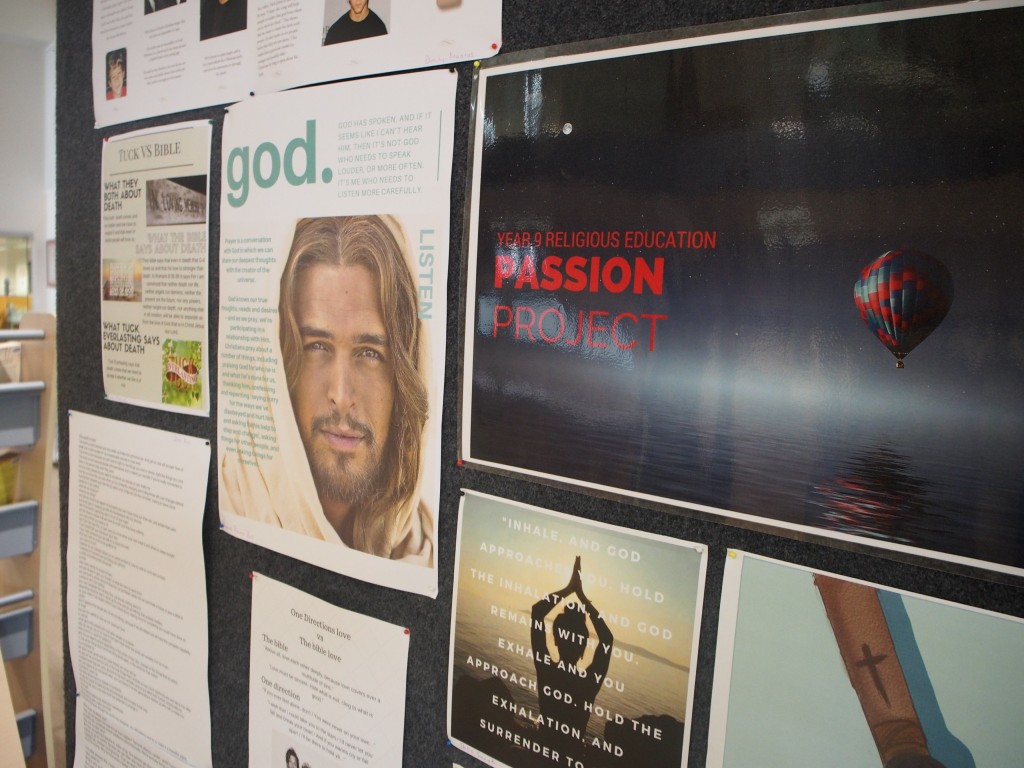


Some student work from the Passion Project that was shared in the library
I don’t like to play favourites with my projects, but the Passion Project was definitely one of the highlights of my Guided Inquiry journey this year. The project was the idea of two Religious Education (RE) teachers who wanted to bring a greater level of choice to their students’ learning, thereby providing a more meaningful and deeper experience in the classroom. They came to me after one of the teachers had collaborated with me using Guided Inquiry in a science project and she thought that the principles could be applied in RE. Religious education in Australia is not tied to the curriculum constraints of other subjects, but is considered a very important part of our school curriculum. Therefore, we had a lot of freedom in our project design…and that made it so much more fun.
The Passion Project asked the students to choose what they would like to focus their study on for Term 3 in relation to Christianity and faith. It asked, “what are you passionate about?” and provided the students with the freedom to ask the big questions related to faith, religion and spirituality. We emphasised that there will not be one answer to your question which was something that some students found challenging and others found exciting.
We opened the project with a number of games which were designed to get the students brainstorming the kinds of things they were passionate about, whether it was Game of Thrones, Justin Bieber or animal cruelty. We used chatterboxes to get conversations started and students worked in partners and small groups to support each other in the creation of a mind map which would form the basis of their Explore phase.

This page of resources held sources for students to use in the EXPLORE phase. Each of the four tiles (e.g. Using the inquiry log, etc) had Youtube videos that I personally created to model information literacy skills.
As we only had one lesson to spend with the students per week, I decided to implement a flipped classroom approach. Students used the learning management software to access videos and instructions on various stages of Guided Inquiry. They also accessed their Inquiry Log and Inquiry Journal for the EXPLORE and GATHER phases. This enabled teachers to spend less time at the front of the classroom teaching skills, and more time for student inquiry and teacher interventions as required. We implemented EVALUATION throughout the process and the classroom teachers used reflections using Google Forms at the beginning of each lesson to gather important information to inform whether the student needed additional support. This also provided valuable feedback which informed whether the students needed more or less time at each stage of the inquiry process.

This is me recording the flipped classroom videos in our very own soundproof recording booth at school! It took many, many takes. Note to self…write a script!
I cannot emphasise enough how important the reflection component was to this task. I have found that the inclusion of reflection is something that requires a bit of persuasion on the part of the teacher librarian or Guided Inquiry practitioner for a number of reasons: there is little time, does it add value, I’m not sure how to do it, etc. Reflection is something I strongly believe in as a teaching tool because it encourages reflective practice both in students and teachers. It encourages us to question how we go about our teaching and learning and provides valuable insight into our students and how they are feeling/thinking/behaving at each stage of the project. It also provides valuable evidence of the impact of teacher librarians – something that we do not always have access to if we are not assessing, reporting and providing formal feedback. In this case, the RE teachers were big fans of reflection and were quite happy to use it to ensure the students were properly supported throughout the project.
I had many interesting discussions with students in the beginning stages of the project. The ISP emphasises the fact that students will go through periods of doubt and uncertainty, and this was true for our students. A couple of students begged me to “just give me a question to answer!”, which only confirmed that the process of making choices is essential for improving information literacy and skills that will help them become lifelong learners throughout their life.
It took the girls 6 weeks to get to the stage where they could begin to plan their creations. This was also a valuable lesson to those who like to jump right in and create before they have a deep understanding of the subject (often this leads to a lot of copying and pasting in my experience). Like the choice of subject area, they were able to choose their method of sharing their findings. We gave the students physical and digital platforms for sharing and this led to many amazing creations. Examples included:
In all, the Passion Project was valued both by teachers and students. Using the Guided Inquiry Design model provided the structure and scaffolding needed to properly ensure that the knowledge that the students gained would be personally meaningful. It also personally allowed me to get creative with my own pedagogy and play around with technology to improve the learning experience. I particularly enjoyed recording the flipped classroom videos. Although this was time consuming in the planning phase, it was worthwhile in the learning phase. All in all, the project was a huge success and will be repeated next year.
Erin Patel